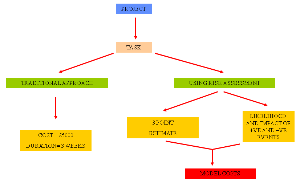Risk management - Risk assessment of a task
Risk assessment of a task
What key aspects exist for risk assessment of an event or task?
We know that for any project we will have to break it down into smaller parts, assess each of these and then add up the components to get the summary.
This can be represented as in the above diagram showing the slightly different approach for the use or non use of risk assessment techniques.
This dissemination of the project is known as preparing a Work Breakdown Structure (WBS). The assessment is then carried out for each of the ‘tasks’ in the Work Breakdown Structure.
These activities, at a particularly low level, may also be called Work Packages.
Remember, initially the level of detail required might be lower to use a top down summary plan to get the risk management process underway.
If too much detail is added the task may become too daunting, raising a lot of minor risks instead of concentrating on the more strategic areas.
No use of risk management
For the majority of projects risk assessment is not often used.
This will involve defining the Work Breakdown Structure, then the individual tasks and finally they are assigned a cost and a duration.
These are often based upon the experience of individuals with the cost being based upon man weeks to complete the task together with any additional costs involved.
The project team will be made up of specialists from various areas and departments. It will be up to the project team members to generate the tasks required within their area.
Each member of the project team can then be assigned the responsibility for one or more of these areas. It is then his job to break down that work level into manageable parts or tasks.
He should do this with regard to:
Identifying the tasks
The level of detail should reflect what can be managed easily. Bearing in mind the need for a more summary report.
Assign durations
These should be realistic not padded. They should take into account the level of resource available to work on the task.
They may be fixed durations.
Allocate responsibilities
There are two schools of thought here. Either assign the task to the person actually carrying out the work or assign a series of tasks to one of the project team members whose responsibility is to see that they get done. The latter method may not assess the overall labour input easily, but has the advantage that it can create greater flexibility.
Costs
Costs can be totalled easily with suitable software, provided the people actually doing the job are identified. The trouble with this approach is you will have to go to the lowest level in the work breakdown structure to get it. It is often more convenient to prepare a schedule at a higher level of work where one or more people are carrying out work towards a specific goal e.g. analysis. This approach requires the person responsible to make an accurate assessment of all elements he / she is responsible for and total the amount.
Produce schedule
This can now be produced in its basic form as a list of tasks, with durations and responsibilities together with start and end dates. However, the next phase of looking at dependencies is required. The updated schedule will then require milestones and checking against corporate objectives prior to agreement.
For much more information on Work Breakdown Structure and ‘Detailed Planning’ [see ‘The Complete Project Management package’] and [see 'The Complete Project Management plus PRINCE2'] in this series.
The above applies for when RISK ASSESSMENT is NOT carried out as part of the planning process.
Use of risk management
When Risk Assessment is used a 3 point estimate is obtained:
MINIMUM
LIKELY and
MAXIMUM values of cost, as we have seen previously [see Simple estimating of risk].
Then:
Uncertain event should be considered. We would assess their likelihood and their impact upon the project.
These can be positive (OPPORTUNITIES) or negative (RISK) impact.
So far, we have only considered negative (RISK) impact, in that they will increase the cost (or duration, or lessen the revenue).
As we have seen before we are also trying to find OPPORTUNITIES.



